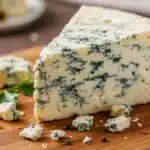Welcome to a flavor journey like no other! If you’ve ever crumbled blue cheese over a salad or savored it in a creamy dressing, you already know—this bold, tangy cheese has a character all its own. But there’s so much more to explore beyond its sharp bite and marbled beauty. Whether you’re a seasoned foodie or just cheese-curious, blue cheese brings a world of taste possibilities to your table.
At Recipes2Gather.com, we believe in making cooking joyful and approachable. This guide will walk you through everything from the benefits of blue cheese to expert tips, creative serving ideas, and a full recipe you’ll want to make again and again. Plus, you’ll find natural internal links like our guide to choosing and using a cheese knife to elevate your cheese game.
Let’s explore the bold and unique flavors that make blue cheese so unforgettable.
Key Benefits for Blue Cheese
Blue cheese is more than just a delicious addition to your cheese board—it’s packed with unexpected benefits that might just make you fall in love with it all over again.
First and foremost, blue cheese is rich in calcium, which is essential for maintaining strong bones and teeth. A small serving delivers a hearty dose, making it a great addition to a balanced diet. It’s also a good source of protein, which helps you stay full longer and supports muscle health.
Beyond nutrition, blue cheese has probiotics—live bacteria that support a healthy gut. These beneficial microbes can aid digestion and support immune function, especially when you enjoy raw or minimally processed varieties. The mold used in blue-veined cheese, Penicillium roqueforti, is safe to eat and gives the cheese its signature tang and complex aroma.
Flavor-wise, blue-veined cheese is a powerhouse. Its salty, sharp, and creamy profile can transform everything from burgers and pasta to dressings and dips. If you’re looking to add excitement to everyday meals, blue cheese brings bold energy to the plate.
For more indulgent cheese experiences, check out our white cheddar flavor expose or dive into the luxurious world of gorgonzola, a close cousin in the blue-veined cheese family.
Ingredients for Blue Cheese
Making your own blue cheese dish at home is surprisingly simple, especially when you start with quality ingredients. Here’s what you’ll need for a classic blue-veined cheese dip that’s rich, creamy, and downright irresistible.

Basic Ingredients:
- 1 cup crumbled blue cheese (preferably Roquefort, Gorgonzola, or Stilton)
- ½ cup sour cream
- ¼ cup mayonnaise
- 1 tbsp fresh lemon juice
- 1 tsp white wine vinegar
- 1 clove garlic, finely minced
- ½ tsp black pepper (freshly ground)
- 1 tsp Worcestershire sauce (optional for depth)
- Pinch of sea salt
You can adjust the ingredients to taste—some prefer more tang (add more lemon), while others want a thicker consistency (use less sour cream). If you’re serving this dip with wings, celery sticks, or a cheese platter, you’re in for a crowd-pleasing treat.
Want to explore how blue cheese pairs with other dairy delights? Our Colby-Jack guide might inspire your next cheesy combination.
Step-by-Step Instructions for Blue Cheese
Follow these simple steps to make a creamy, flavorful blue cheese dip that’s ready in just minutes.

- Mash the Cheese:
Use a fork or spoon to mash the blue cheese in a mixing bowl until it’s mostly creamy with a few chunks left for texture. Leave a few chunks for texture. - Mix the Base:
Add the sour cream and mayonnaise. Stir it all up until the texture’s nice and creamy, with everything fully mixed in. - Add Flavor:
Pour in the lemon juice, vinegar, minced garlic, Worcestershire sauce (if using), salt, and pepper. Stir thoroughly. - Let It Rest:
Pop it in the fridge for about 30 minutes so the flavors have time to come together—it makes a big difference in taste. - Serve or Store:
Serve chilled as a dip or drizzle over salads, burgers, or steak. Pop any leftovers into an airtight container and refrigerate—it’s best enjoyed within five days.
If you love comfort foods, don’t miss our mac and cheese bowl recipe which pairs perfectly with a drizzle of this dip.
Pro Tips and Variations for Blue Cheese
There’s no limit to the ways you can enjoy blue cheese, and here are a few ideas to make the most of every bite.
Pro Tips:
- Use room temperature cheese to make mixing easier and flavors more pronounced.
- If you like it extra silky, give the dip a quick spin in your food processor.
- Store in a glass container to preserve the taste without absorbing fridge odors.
Flavor Variations:
- Spicy Twist: Want some kick? Toss in a splash of hot sauce or a pinch of cayenne to turn up the heat.
- Herbaceous Version: Mix in finely chopped chives, parsley, or dill.
- Creamier Option: Swap sour cream for Greek yogurt to up the protein content.
- Smoky Finish: Try adding a touch of smoked paprika for warmth.
This cheese is highly versatile, making it a great upgrade in recipes like our cheesy garlic chicken wraps or even dolloped on baked potatoes.
Serving Suggestions for Blue Cheese
Here’s where you can have fun and put your personal spin on it. blue-veined cheese adds a luxurious note to almost any dish when used thoughtfully.
Classic Pairings:
- Crumble it over salads, especially those with fruit like pears, apples, or figs.
- Serve it with crusty bread, nuts, and honey on a charcuterie board.
- Melt it into creamy sauces for steak or pasta.
Unexpected Favorites:
- Use as a topping on a gourmet burger with caramelized onions.
- Stir into mashed potatoes for a rich, tangy upgrade.
- Spread on crostini with roasted grapes or balsamic glaze.
Try pairing it alongside dishes like our port wine cheese spread or old-fashioned pimento cheese for a full-flavored cheese lover’s night.
Insights on Blue Cheese
- According to Healthline, blue cheese contains anti-inflammatory compounds that may support overall health.
- Serious Eats offers a deep dive into how blue cheese is made and stored for optimal taste.
- Bon Appétit shares tips on storing cheese, including blue, to prevent spoilage and keep it flavorful longer.
Conclusion
Blue cheese isn’t just another cheese—it’s an experience. With its complex flavor, health perks, and endless versatility, it deserves a permanent spot in your fridge. From dips to dressings, from burgers to boards, blue-veined cheese brings boldness to the table in every form.
At Recipes2Gather.com, we’re all about making meals that connect us, even through the funk of blue cheese. Once you’ve nailed the foundation, feel free to mix things up and play with flavors. Because the best meals are the ones we gather around together.
Print
Blue Cheese: History, Types, and Culinary Uses
- Total Time: 10 minutes + 30 minutes chilling
- Yield: 1½ cups
- Diet: Vegetarian
Description
This creamy blue cheese dip is bold, tangy, and perfect for salads, wings, or spreading on crostini. A delicious, easy-to-make crowd-pleaser.
Ingredients
- 1 cup crumbled blue cheese
- ½ cup sour cream
- ¼ cup mayonnaise
- 1 tbsp lemon juice
- 1 tsp white wine vinegar
- 1 garlic clove, minced
- ½ tsp black pepper
- 1 tsp Worcestershire sauce (optional)
- Pinch of sea salt
Instructions
- Mash the Cheese: Mash blue cheese in a bowl, leaving some small chunks.
- Mix the Base: Stir in sour cream and mayo until combined.
- Add Flavor: Add lemon juice, vinegar, garlic, Worcestershire, salt, and pepper. Mix well.
- Let It Chill: Cover and refrigerate for 30 minutes.
- Serve Fresh: Serve chilled or store in fridge up to 5 days.
Notes
Blend for a smoother texture. Use Greek yogurt for a healthier variation.
- Prep Time: 10 minutes
- Cook Time: 0 minutes (no cooking required)
- Category: Appetizer
- Method: Mixing
- Cuisine: American
FAQs
1. Is blue cheese safe to eat if left out overnight?
It’s not recommended. You can read our full guide on blue cheese food safety for more detail.
2. Can I freeze blue cheese dip?
Freezing is not ideal as it can alter texture. It tastes best when eaten within a couple of days while it’s still fresh.
3. What sets Gorgonzola apart from other blue cheeses?
Gorgonzola, an Italian variety of blue cheese, is known for being softer and less sharp than Roquefort or Stilton.
4. Is blue cheese suitable for vegetarians?
Check the label. Some blue-veined cheeses use animal rennet, while others use microbial alternatives.
5. Is it okay to cook with blue cheese in warm recipes?
Absolutely. It melts well and adds a rich, sharp note to sauces, pastas, and even stuffed chicken.


1 thought on “Blue Cheese Bliss Uncovered with Irresistible Flavor”